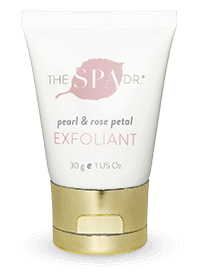Exfoliation plays an important role in your skincare regimen. Done correctly, exfoliation helps remove dead, dull surface skin cells to reveal the fresh, glowing skin underneath. It also helps your skin remove toxins and even enhances the effectiveness of your daily skincare routine.
You want to avoid over-exfoliation as it can cause inflammation and may even damage your skin’s microbiome. I’m sharing my exfoliation best practices to help you enjoy the benefits of exfoliating without the risk.
What Is an Exfoliant?
 There are numerous exfoliants, but only two main types: physical and chemical.
There are numerous exfoliants, but only two main types: physical and chemical.
Chemical exfoliants have enzymatic properties that help slough off dead skin cells. Physical exfoliants are those that contain a “scrub” type ingredient to cause the exfoliation. Avoid exfoliants with coarsely ground ingredients because they may cause microscopic tears that damage the skin. The Spa Dr.’s formula uses very finely ground cultured freshwater pearls to create a gentle yet effective physical exfoliation effect.
How Often Should You Exfoliate?
Your exfoliation schedule depends on your skin type. In general, though, you can safely exfoliate one to two times per week, with sensitive types doing best with a once per week schedule. A truly mild exfoliant can be used more often, particularly by oily skin types.
If you’re not sure when to exfoliate, common signs that it’s time include:
- Rough or dry skin
- Congested skin, i.e. blackheads and whiteheads
- Pores visibly large
- Skin appears oily
What Should You Look for in an Exfoliant?
You want to look at the ingredients, specifically at what is causing the exfoliation. As you know, I believe the best skincare products are made using natural ingredients that nourish and love your skin – essential oils and extracts that are teeming with nutrients, antioxidants, and anti-inflammatory properties. You should also look for products balanced to your skin’s pH, which helps protect its microbiota. And, avoid products that contain harsh physical exfoliants, particularly plastic beads and other coarsely ground items.
What Should You Expect from an Exfoliant?
When you use an exfoliant correctly, your skin should look and feel softer. There should be a beautiful glow, brighter appearance, and overall smoother skin.
Regular exfoliation may also help reduce the appearance of fine lines and breakouts. Another bonus is that your other skincare products are better absorbed by your skin, which means they become more effective.
What Is the Correct Exfoliation Technique?
You should always use products according to the instructions provided. However, generally speaking, you exfoliate after cleansing your skin but before completing the rest of your skincare regimen.
Use a small amount of exfoliant – around the size of a pea – and dot it over your face and neck before working it in. Use a light touch; you don’t need a lot of force. Let the exfoliant do the work for you. Work the product over your skin using circular movements, being extra gentle in the eye area (assuming you’re using a natural, mild exfoliant). Again, do not forget the neck and décolletage. Finally, rinse thoroughly, pat dry, and complete the remaining steps in your daily skincare routine.
What Is the Right Exfoliant for Your Skin Type?
A gentle, natural exfoliant, like the Pearl and Rose Petal Exfoliant, is good for all skin types, because it is not harsh for sensitive skin. If your skin is extremely oily, you can use it more than twice a week.
The best way to determine the ideal exfoliant and skincare regime for your skin is to talk to a licensed esthetician.
When Should You Not Exfoliate?
Although exfoliation offers plenty of benefits, it can also harm your skin if you don’t follow best practices. Avoid exfoliating during the following circumstances:
- If you plan to be in direct sunlight for an extended period of time
- If you have extremely sensitive skin
- If you’re using a dermatology prescription, such as topical steroids, antibiotics, retin-A, and Accutane
- If your skin is broken, inflamed, sunburned, or otherwise damaged
- If you have been swimming or hot-tubbing in chlorinated water
- If your face is windburned, such as after a day of skiing
The Best DIY Exfoliant Ingredients
You can make wonderful DIY exfoliants using ingredients from your kitchen. In my book, Clean Skin from Within, I share numerous recipes for homemade skincare products using all-natural ingredients.
If you are allergic to any of these foods, do not use them in your homemade skincare products!
- Almonds: Natural exfoliant when ground into a fine powder; rich in anti-oxidants
- Avocado: Contains vitamins A and E; great for moisturizing and hydrating your skin
- Natural honey: Has powerful antimicrobial and anti-inflammatory properties; contains vitamins B1, B3, B5, and B6 as well as potassium and calcium
- Oats: Anti-inflammatory properties promote healing; moisturizes and cleanses skin so it doesn’t dry out
- Papaya: A rich source of vitamins A, C, and E; contains the papain enzyme which is a natural exfoliant
- Pomegranate seeds: Grind these in a blender until smooth for an anti-oxidant-rich exfoliant
- Strawberries: A rich source of vitamin C; brighten skin naturally
- Yogurt: The lactic acid in yogurt is a natural exfoliant; helps balance skin’s pH
Whether you’re making your own DIY exfoliant or looking to purchase one made with natural and organic ingredients, such as the Pearl and Rose Petal Facial Exfoliant, exfoliation is a key part of an optimal skincare routine.

